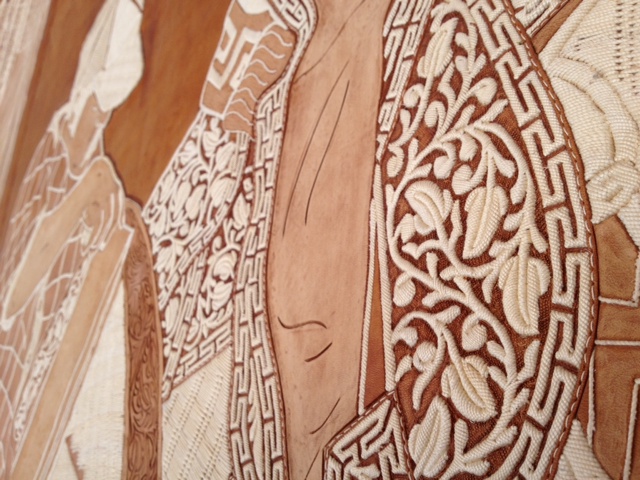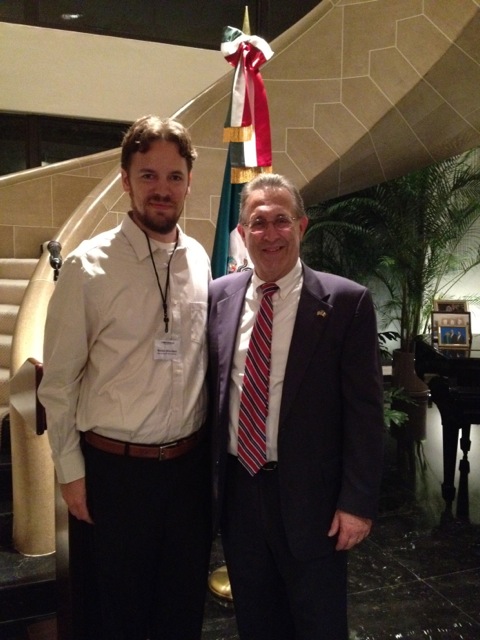Dispatch from Northern Jalisco - An Introduction

Greetings to Ethnomusicology Review readers! I’m delighted to begin my correspondence from Colotlán, Jalisco, México. As many of you know, Jalisco is often considered the home of what we might think of as stereotypically Mexican: mariachi, tequila, and the traje de charro. Additionally, the modest city of Colotlán rightly considers itself to be the world capital of piteado, a type of hand-embroidering that commonly adorns belts, saddles, and other leatherworks from this region (see photos below).

Piteado Mural in Casa Hidalgo, Colotlán, Jalisco, Mexico

Detail of Piteado Mural (showing why it was a multi-year work)
Despite the fact that I’m an “ethnic Hoosier” born and raised in a small Indiana city surrounded by farmland, the rural feel of Colotlán takes some adjustment. It is not uncommon to see a man riding a donkey down the street in front of our house, or horses left unattended to graze in vacant lots or along the side of the road. Here, you don’t drink the tap water but you do eat homemade queso fresco made with raw milk on a metate. When it rains, the dirt road next to our house literally turns into a creek. Traffic problems are often the result of cattle being herded and you get the town news not from a local newspaper—there is none—but through the group of neighbors assembled on the sidewalk to chat in the evening hours. Though this is my wife’s hometown, we and our 9-month-old daughter are all trying to get adjusted to this huge lifestyle change.
More importantly for my dissertation research, this region is home to the Wixaritari, an indigenous group also known as the Huicholes or Huichols. Though I’ll use future blog posts to touch upon my dissertation material, themes, and theories, in short the project is a multi-sited and somewhat comparative study of both traditional music of remote Wixarika communities and “Huichol” groups that travel regional circuits performing popular Mexican music (corridos, rancheras, etc.). The samples below give an idea of these different spheres of música wixárika, the first recorded by a colleague from Guadalajara.
The study of these musical practices should help get at one of the central theoretical concerns of my dissertation, that is the construction and commodification of Huichol identity as a "virtual object" or brand, and the historical role of ethnographers and other outsiders in that process. The problem I intend to address has been outlined well in Ethnicity, Inc. by Comaroff and Comaroff; the propagation of an ethnic identity into the global marketplace creates a paradox in which said identity seems to be strengthened or made more sustainable by market presence, while simultaneously seeming to undermine or weaken cultural practices that served to make the identity unique or “valuable” in the first place.
I’m lucky to have two subventions supporting this project, one from Fulbright-IIE and the other from UC MEXUS. The Fulbright program hosted an orientation session last week in Mexico City. In addition to actual “orientation” sessions, we were able to learn about the projects of other grantees, a true panoply of disciplines, topics, and backgrounds from all over the U.S. After some requisite touristy group excursions (Teotihuacan, Templo Mayor, etc.) we were treated to a reception at the residence of the U.S. Ambassador in the posh Bel Air-like neighborhood of Lomas de Chapultepec. Never have I experienced my tax dollars put to such good use as when I and fellow grantees genteelly wiped our fingers on napkins emblazoned with the Great Seal of the United States.

Nolan with Earl Anthony Wayne, U.S. Ambassador to Mexico
No matter what your field or research interest, a stay in Mexico City is never complete without a trip to the used and rare bookstores on Calle Donceles. For a bibliophile, this street is like a drug—you can get carried away with it, to say the least. If you like books and find yourself in Mexico City, give yourself an entire day here.

One of many used and rare librerías on Calle Donceles in Mexico City
Now back in more modest digs in Colotlán, I’m beginning to learn spoken and written Wixárika, but this and other topics I’ll save for later posts. This “get-to-know-you” entry is merely an introduction and I look forward to any correspondence this and future topics might generate. Hope to hear from some of you… and if you find yourself in northern Jalisco, feel free to stop by. Just ask around for the tall güero.





